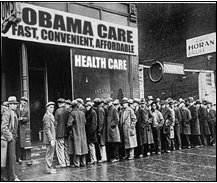Earlier this week, the Congressional Budget Office released its cost-estimate of the Baucus-led bill on the Senate side. Simply put: it is fatally flawed. And, those flaws must be exposed.
By 2019, CBO estimates, 29 million more people will be covered with taxpayer-subsidized care. It estimates the final cost will be $829 billion over 10 years. Unfortunately for Congress, which depends upon these estimates to make informed judgments about legislation, this is misleading.
CBO estimates on average that the total cost per individual per year will only be about $2,858—the cost of providing subsidized care to 29 million at a price of $829 billion. The problem is: the average cost of a premium in the United States is $4,700. Either the government plans on expanding coverage by providing below-average, substandard care — or the cost estimate is grossly understated.
In the former case, CBO makes the essential case that indeed one of the ways Barack Obama plans on paying for his plan is through rationing. Indeed, the bill apparently cuts Medicare and Medicaid by approximately $404 billion. CBO describes these cuts, “The proposal would make numerous changes to payment rates and payment rules in those programs…” In other words, the Senate plans lowering doctor payments, thereby incentivizing more of them to increasingly cap or refuse to take government-subsidized providers since the bill does nothing to rein in the costs of medical treatment.
More likely, though, in the latter case, the cost estimates are simply (and, perhaps, deliberately) understated. For example, CBO estimates that a government program in which 91.5 million people under the age of 65 are technically eligible for will only result in 29 million new enrollees. According to the estimate, taxpayers would subsidize care for those making 400 percent above the poverty level, or individuals who make $43,320 a year or less.
Unfortunately for taxpayers, according to the U.S. Census Bureau, that includes 91.5 million people under the age of 65, or 125.8 million in total, who would meet the income requirement.
Currently, only 80.5 million now receive their health care from the government. That means the Senate plan could expand government-run health care to 45 million additional people. The cost? At an average of $4,700 per premium, that would cost an additional $2.1 trillion over ten-years once fully implemented.
Which, of course, is unsustainable. That is why, over time, the quality of care would have to be watered down—i.e. rationed. Not even the tax increases of $406 billion that the bill proposes would be able to pay for it.
Therefore, the real problem with government-run health care, and all government entitlements, is its future burden to taxpayers and yet-unborn generations. Such programs are simply unsustainable. By 2020, according the Medicare and Social Security Trustees Reports, in addition to payroll taxes and premiums, Medicare and Social Security combined will also require an extra 27 percent of federal revenue. By 2030, the programs will need 49 percent of taxes to stay afloat. By 2040, 61 percent. In total, through the century these entitlements constitute some $107 trillion in unfunded liabilities.
How much more that will be if Congress expands taxpayer-subsidized health coverage to 45 million is anyone’s guess. But it will be trillions.
Therefore, the Senate should not be fooled by rosy estimates proclaiming that expanding health coverage to tens of millions can be done without shackling the nation to a mountain of debt that can never possibly be paid back. By now, they should know better. The American taxpayer surely does.


